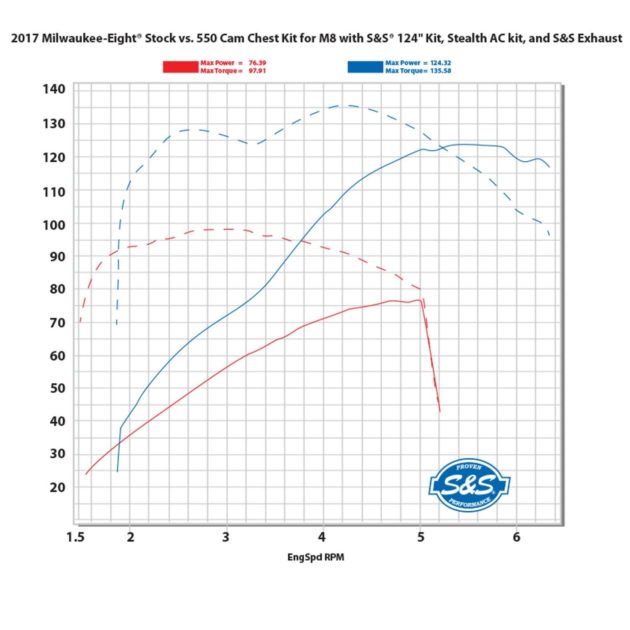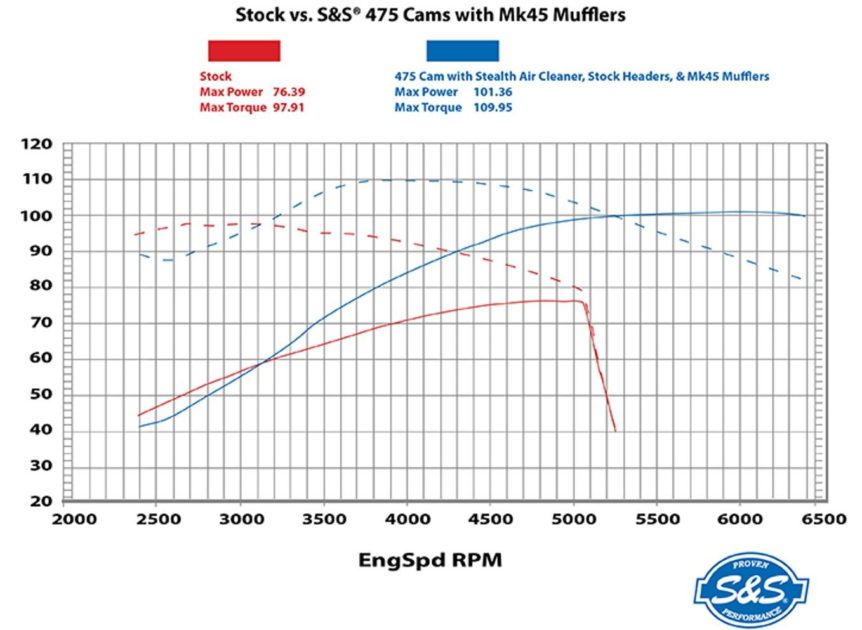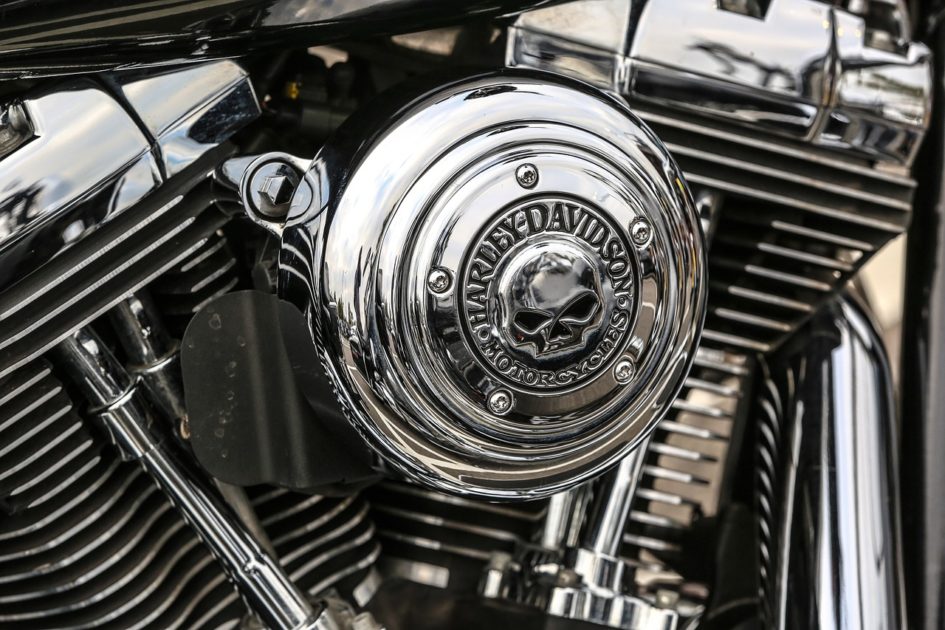If you’re looking to add some more pep to your Harley Davidson M8 114, a new camshaft might be just what the doctor ordered.
But with so many different and confusing types of cams available for the M8 114, which one should you choose? Do you go for something with lots of torque down low, or something that maximizes horsepower at the top end? How do you know what’s going to work best for your bike and how do you make sure that the installation is done properly?
Well, don’t worry – we’re here to help.
In this blog article, we’ll take a look at the best cams for M8 114 and provide some tips on how to select the right one for your bike.
Also Read: The Best Big Bore Kit For Twin Cam 88
The 4 Best Cams for M8 114
Best HP Cam 1. S&S Cycle 550G |
| Check Price On Amazon | |
Best Top End 2. COMP Cams Mega 8 246/252 |
| Check Price On Amazon | |
Best Touring 3. S&S Cycle 310-1014A |
| Check Price On Amazon | |
Most Aggressive 4. COMP Cams Mega 8 Hi-Lift 248/254 |
| Check Price On Amazon |
1. S&S Cycle 550G
The S&S Cycle 550G cam is the perfect horsepower camshaft designed specifically for the M8 114 engine. With a lift of .550 inches and intake duration of 218.9 front and 214.2 rear with a 103 LSA, you’ll be making peak HP at around 5800 RPM.
How much HP exactly? Well, if your Milwaukee 8 114 has a performance intake and exhaust, you’ll be making around 120.91 HP, according to the S&S dyno sheet.

Not only does the S&S 550G give you more HP at high revs, but it also produces peak torque of 128.65 at 4100 RPM, which is pretty impressive for such an aggressive cam. This translates into a great powerband with a bit more focus on higher RPMs.
Now, with the most important specs out of the way, there are a few things that you need to know when buying the S&S Cycle 550G cams.
First, the 550G replaces the drive chain and tensioner on the M8 with gears. There are quite a few benefits to gears over the timing chain. The biggest advantage to having gears is that you won’t need to worry about your drive chain failing or getting worn and slacking, as gears should last you a lifetime.
Another big advantage to gears over chain is more precise valve timing. While the chain stretches a little bit and causes a tiny delay in valve timing, gears do not. This allows for more precise valve timing accuracy. However, the main disadvantage to gears is that they are more expensive to install and are a bit noisier.
If a drive gear conversion is not your thing, then S&S cycles offer the same 550 lift cam but with the stock chain setup. The chain cam kit is called 550C (C as in for Chain).
Lastly, these 550 lift cams are really aggressive and therefore they must be paired with adjustable pushrods and heavy duty valve springs. This will make the total price of the cam swap higher, but there’s no going around that. Performance adjustable pushrods and valve springs are a must.
2. COMP Cams Mega 8 246/252
Want to push your peak HP even higher up the rev range? Then you need the COMP Cams Mega 8.
This cam is perfect for riders who love to trash their Harleys at screaming high RPMs,
With a .472″ lift, 246/252 duration, and 110 LSA – these cams produce peak HP of 125 at the very top-end. In my opinion, these cams are by far the most fun to ride if you like riding fast, and oh boy are they fast.
Another great thing about the Mega 8 246/252 is that the torque comes in quick at 2000 RPM and stays relatively consistent pretty much throughout the whole range. This makes the M8 more predictable and consistent than you would expect, at least before the peak HP hits.
Now, like with all high-performance cams, you will need to get adjustable pushrods and heavy duty valve springs to run the COMP Cams Mega 8 246/252 without any problems.
3. S&S Cycle 310-1014A Cam Chest Kit
But what if you want huge torque down low? Then you need the S&S Cycle 475G cam.
These are the best cams for low-end torque, with a duration of 213.5/263.9 and an LSA of 102. These cams produce peak torque of 109.95 at just 3000 RPM and will make your Harley pull like a train instantly! The perfect choice for touring or riding two up.
If you’re looking for a cam that will give you great low-end power without sacrificing too much high-end power, then the S&S 475G is perfect for you.

Another huge pro of this cam is that it’s a complete bolt-in, which means that you don’t need to upgrade your valve springs or anything like that – it will work perfectly fine with a stock setup and produce 100HP.
However, the 310-1014A is a full kit from S&S and I highly recommend going with it as it comes with a better oil pump, much stronger tappets, adjustable pushrods, and cam gears to replace the cam chain. It’s a bit more expensive, but it’s 100% worth it if you want to do the swap properly and have it last for the life of the engine.
Lastly, the 475 cam is one of the best sounding cams out there. It has a nice lope to it when idling, which is just a cherry on top.
4. COMP Cams Mega 8 Hi-Lift 248/254
Last but not least, we have the COMP Cams Mega 8 Hi-Lift 248/254 – arguably the most aggressive cam on the list.
With performance intake, exhaust, and ported heads, the Mega 8 Hi-Lift 248/245 should level up your M8 to a crazy 138 HP and more!
The cam has a lift of .522″ and a duration of 248/254 at .053″ with an LSA of 110, which will produce peak of 138+ HP at the top end of the RPM range. The torque is also moved up higher and should peak at 4000 RPM.
This cam is really only for experienced riders who know how to handle a lot of power and love to stay in the high RPM range. However, if you’re looking for the best possible performance out of your Milwaukee 8, then the Mega 8 Hi-Lift 248/254 is the way to go.
Just like with all high-performance cams, you will need to get heavy-duty pushrods, high-performance valve springs, and high compression pistons to run the COMP Cams Mega 8 246/252 without any problems.
How To Choose The Best Cam for M8 114
Now that you’ve got an idea of some of the best cams out there for M8 114, it’s time to figure out which one is right for you.
Determine Your Riding Style
The first and most important thing you need to do is determine your riding style. Are you a casual rider who likes to take it easy on the streets? Or are you an experienced rider who loves to push your bike to the limit?
If you’re a casual rider, then you’re probably better off with mid cams, like the S&S Cycle 475G. They have lots of torque down low and at the mid-range – exactly where you’re most likely to be when cruising down the street.
However, if you’re an experienced rider who loves to ride fast and hard, then you should probably go with aggressive cams that move the peak torque and horsepower to the upper range. These cams, like the COMP Cams Mega 8 Hi-Lift 248/254, will give you the best performance when you’re pushing your bike to the limit.
Choose How You Want Your Harley To Perform
Once you’ve considered your typical riding style, it’s time to decide whether you want your Harley Davidson to have instant power at cruising RPMs, huge power at high RPMs, or something in between?
You can only have one of the three. If you make most power down low, then you’ll be sacrificing power in the high end and vice versa.
For example, more torque at low RPMs or the midrange is ideal for two-up riding or general touring applications, as you have all the power right then and there without having to downshift.
For spirited riding and pushing you and your HD to the limit, you’ll want peak HP at high RPMs.
Consider The Mods That You Already Have Installed
This is where it gets more tricky. You need to consider which mods you already have and which ones you’re planning on doing in the future.

You can’t simply slap on the most aggressive cams with the biggest numbers and call it a day, otherwise, you will be very disappointed and surprised with how horribly your Milwaukee 8 runs. Aggressive cams need supporting mods.
For example, S&S Cycle 550 is a very aggressive cam and it’s pretty much as close as you can get before you must get high compression pistons installed. At the very minimum, this cam needs a performance air filter and exhaust, adjustable lifters, and high-performance valve springs. If either one of these is missing, then your M8 will be disappointingly sluggish.
Now, if your M8 114 is mostly stock, apart from a performance intake and exhaust (which are a must), then you can get quite a lot of results from a bolt-in cam. Bolt-in cams are designed to provide the most HP and torque without the need to change the valve springs, which is quite a big job in itself.
Of course, bolt-in cams won’t provide as many power gains as aggressive cams, but they do make a huge difference at a fraction of the cost. For example, the S&S Cycle 475 is a great bolt-in all-around cam, and it will easily get you to the 100HP mark with the stock valve springs.
Understand The Key Cam Specs
Last but not least, you need to understand how to read a cam specs sheet in order to gauge the potential characteristics of a specific cam. There are a lot of confusing terms and numbers, so we recommend you to first pay attention to the three key specs before you consider the others, otherwise, you will get overwhelmed easily.
Lift
The purpose of a camshaft is to lift the valves, and the lift is a very important measurement of how far the camshaft lifts the valves. It is measured in fractions of an inch.
For example, aggressive cams have a .550″ lift, while a more mild cam will have a .460″ lift. The higher the number, the higher the valve lift.
But what does that actually translate to when it comes to power? Well, more lift usually translates to more power at mid-range and high-range RPMs. More lift = more airflow to the combustion chamber.
Duration
The second most important spec is duration. It specifies how long the valve stays open and it’s expressed in degrees of crankshaft rotation. All you need to know first, is that the higher the number, the higher the duration. For example, a cam with 240° of duration, holds the valve open longer than a cam with 210° duration.
A longer duration improves low range torque and idle, but sacrifices top-end HP. A shorter duration improves HP at high-end, but sacrifices torque at low RPMs and makes the bike idle worse.
Valve Timing
Last but not least – valve timing. This is a very important spec, as it determines when the valves open and close in relation to the piston’s position.
It is measured in degrees of crankshaft rotation and it is expressed as “intake opens/closes X degrees ATDC” and “exhaust opens/closes X degrees ABDC”.
Without going too much into the theory:
A late opening intake valve (0°) increases power at low RPMs and idle but sacrifices high RPM power, and an early opening intake valve (20°) increases power at high RPMs but sacrifices low RPM power and idle quality.
An early closing intake valve (30°) will provide the most power at the bottom and mid range, while a late closing intake valve (10°)will put most power at the very top end.
A late opening exhaust valve (5°) will provide more power at low RPMs, while an early opening exhaust valve (30°) will sacrifice the bottom end and mid for great power at very high RPMs.
An early closing exhaust valve (5°) will give a smoother idle, better emissions and gas mileage, while a late closing exhaust valve (20°) sacrifices idle, gas mileage, emissions, and low RPM power for a better top end.
Now that you know the three key specs of a cam, you can start looking at other important numbers such as lobe separation angle, but we will leave that for another article.
Final Thoughts
Picking the best cam for your Harley Davidson M8 114 can be a daunting task, but we hope that our article has made it a little bit easier for you.
Just remember to take into account the intended use of your bike, as well as your own riding style, and you will be able to find the perfect cam for you.
And last but not least, don’t forget to consult a professional if you are unsure about anything!
Jake is the site’s primary contributor.
Motorcycles and automotive repair have been a big part of his family for generations, therefore it’s only natural that he decided to become a heavy-duty diesel tech.
Outside of work, you’ll find Jake restoring and riding rare street bikes and ATVs.


